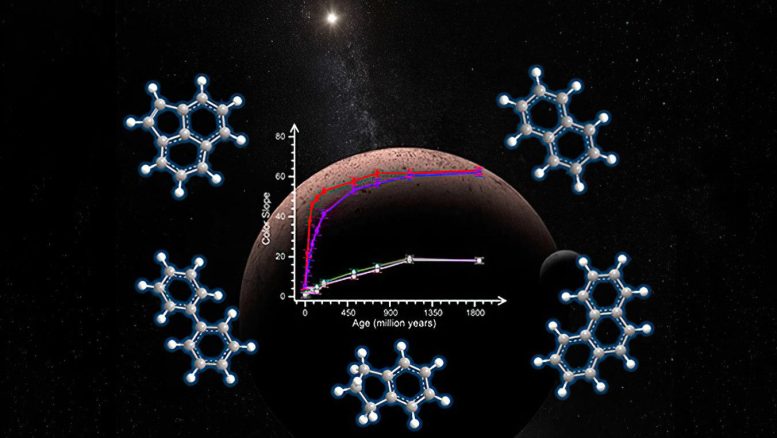
Aromatic structures linked through unsaturated hydrocarbon chains drive the color variety of hydrocarbon rich surfaces of Kuiper Belt objects. Credit: University of Hawaii at Mānoa
The Kuiper Belt, a vast disk brimming with icy bodies including Pluto and located just beyond Neptune’s orbit in our solar system, exhibits an intriguing color palette ranging from stark white to deep reddish hues on its objects. This distinctive color range, unique among all solar system populations, has long remained a mystery. The prevailing theory among scientists has been that the varied colors likely arise from the enduring radiation exposure of organic materials by galactic cosmic rays.
A new study led by the University of Hawaiʻi at Mānoa’s Department of Chemistry researchers has replicated the environment in the Kuiper Belt to discover what is causing the array of colors in hydrocarbon-rich surfaces of Kuiper Belt objects, providing a solution to a long-standing problem in astrophysics. The study was recently published in the journal Science Advances.
The research team led by Professor Ralf I. Kaiser performed the cutting-edge research at UH Mānoa. They used ultrahigh vacuum irradiation experiments and conducted comprehensive analyses to examine the color evolution and their source on the molecular level as galactic cosmic rays processed hydrocarbons, such as methane and acetylene, under Kuiper Belt-like conditions.
Aromatic (organic molecules with fused benzene rings) structural units carrying up to three rings, for example in chemical compounds phenanthrene, phenalene, and acenaphthylene, connected by hydrogen-deficient bridges among each other were found to play a key role in producing reddish colors. The UH experiments demonstrated the level of molecular complexity of galactic cosmic rays processing hydrocarbons and provided insight into the role played by ices exposed to radiation in the early production of biological precursor molecules, a molecule that participates in a chemical reaction that produces another molecule.
“This research is a critical first step to systematically unravel the carriers of the molecular units responsible for hydrocarbon-rich surfaces of Kuiper Belt objects,” Kaiser said. “Since astronomical detections also detected, e.g., ammonia, water, and methanol, on the surfaces of Kuiper Belt objects, further experiments on the cosmic ray processing of these ices hopefully reveal the nature of the true color diversity of Kuiper Belt objects on the molecular level.”
Reference: “Processing of methane and acetylene ices by galactic cosmic rays and implications to the color diversity of Kuiper Belt objects” by Chaojiang Zhang, Cheng Zhu, Andrew M. Turner, Ivan O. Antonov, Adrien D. Garcia, Cornelia Meinert, Leslie A. Young, David C. Jewitt and Ralf I. Kaiser, 31 May 2023, Science Advances.
DOI: 10.1126/sciadv.adg6936









More properly the Edgeworth-Kuiper Belt. Just like the Uda-Yagi Antenna and the Geiger-Mueller Tube.